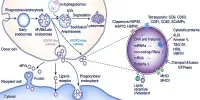Restoring key brain rhythms may hold promise for treating depression. The electrical activity of the brain is known to play an important role in regulating various cognitive and emotional processes, and disruptions in these rhythms have been linked to mental health disorders such as depression.
A new study in mice and rats discovered that restoring certain signals in a brain region responsible for smell processing alleviated depression. A new study in mice and rats led by researchers from NYU Grossman School of Medicine and the University of Szeged in Hungary discovered that restoring certain signals in a brain region that processes smells counteracted depression.
The findings, which were published online in the journal Neuron, revolve around nerve cells (neurons), which “fire” – or emit electrical signals – to transmit information. Recent research has revealed that effective communication between brain regions necessitates groups of neurons synchronizing their activity patterns in repetitive periods (oscillations) of joint silence followed by joint activity. One such rhythm, known as “gamma,” repeats approximately 30 times or more per second and is an important timing pattern for the encoding of complex information, which may include emotions.
According to previous studies, depression is reflected in gamma oscillation changes as an electrophysiological marker of the disease in brain regions that manage the sense of smell, which have also been linked to emotions. The olfactory bulb, which is located near the nasal cavity, is thought to be a source and “conductor” of brain-wide gamma oscillations.
Our experiments revealed a mechanistic link between deficient gamma activity and behavioral decline in mice and rat models of depression, with signal changes in the olfactory and connected limbic systems similar to those seen in depressed patients.
Antal Berényi
To test this theory, the current study authors used genetic and cell signaling techniques to disable the function of the bulb, observed an increase in depression-like behaviors in study rodents, and then reversed these behaviors using a device that increased gamma signals in the brain at their natural rate.
“Our experiments revealed a mechanistic link between deficient gamma activity and behavioral decline in mice and rat models of depression, with signal changes in the olfactory and connected limbic systems similar to those seen in depressed patients,” says Antal Berényi, MD, Ph.D., adjunct assistant professor in the Department of Neuroscience and Physiology at NYU Langone Health. “This study demonstrates the potential of gamma-enhancement as a treatment for depression and anxiety in cases where available medications are ineffective.”
According to the researchers, major depressive disorder is a common, severe psychiatric illness that is often resistant to drug therapy. The condition’s prevalence has risen dramatically since the pandemic began, with more than 53 million new cases estimated.

Gamma Waves Linked to Emotions
Changes in the timing and strength of gamma signals from the olfactory bulb to other limbic system brain regions, such as the piriform cortex and hippocampus, that may be caused by infections, trauma, or drugs, may alter emotions. The research team does not know why. According to one theory, depression arises from changes in the olfactory bulb’s outgoing gamma patterns to other brain targets, rather than from the olfactory bulb itself.
The removal of the bulb is an older animal model for the study of major depression, but it causes structural damage that may cloud researchers’ understanding of disease mechanisms. As a result, the current research team devised a reversible method to prevent damage, beginning with a single, engineered strand of DNA encapsulated in a harmless virus that, when injected into neurons in rodent olfactory bulbs, caused the cells to build specific protein receptors on their surfaces.
This allowed the researchers to inject a drug into the rodents, which spread throughout the system but only shut down the neurons in the bulb that had been engineered to have the drug-sensitive receptors. The researchers were able to selectively and reversibly turn off communication between the bulb partner brain regions in this manner. These tests revealed that chronic suppression of olfactory bulb signals, including gamma, induced depressive behaviors not only during the intervention but also for days afterwards.
The team used several standard rodent depression tests, including measures of anxiety, to demonstrate the effect of gamma oscillation loss in the olfactory bulb. The field recognizes that animal models of human psychiatric conditions will be limited, and so uses a battery of tests to measure depressed behaviors that have proven useful over time.
Specifically, the tests looked at how long animals would spend in an open space (a measure of anxiety), whether they stopped swimming earlier when submerged (measures despair), whether they stopped drinking sugar water (took less pleasure in things), and whether they refused to enter a maze (avoided stressful situations).
The researchers then used a custom-built device to record natural gamma oscillations from the olfactory bulb and then sent those paced signals back into the rodents’ brains as closed-loop electrical stimulation. The device could either suppress or amplify gamma in healthy animals. In humans, suppressing gamma oscillations in the olfactory lobe induced depression-like behaviors. Furthermore, reintroducing an amplified olfactory bulb signal into the brains of depressed rats restored normal gamma function in the limbic system and reduced depressive behaviors by 40% (near normal).















